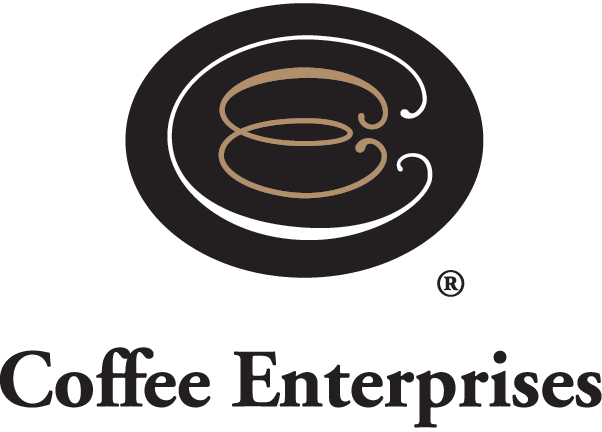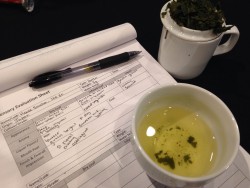Tea People Are a Lot Like Coffee People
Coffee Analysts’ staff members Gwen Toohey and Spencer Turer attended the WorldTeaExpo in May in preparation for increased tea testing capabilities at Coffee Analysts. Here are their observations on the event.
Gwen’s Observations:
The pursuit of tea, professional or otherwise, is part spiritual path and part precise process of technical prowess and mastery. This was clearly exhibited at the World Tea Expo event in Long Beach, CA, one of the major tea business and education hubs in North America.
On Day 1 of the expo, I took the first step toward a Tea Specialist certification with the Core 1 Essentials of Camellia sinensis class. The class is the first in a 7-part certification course run by the World Tea Academy, an internationally recognized educator in tea training and education. The one-day intensive course covered all aspects of tea processing, chemistry of the plant, professional tea cupping protocols and sensory evaluation, and concluded with a hands-on cupping of the 6 primary tea types: white, yellow, green, oolong, black, and dark.
Day 2 expanded further on these topics with the World Origins Tasting Tour, an all-day series of lectures accompanying the evaluation of several dozen different teas from around the world, including highlights from China, Taiwan, and Nepal.
We ended the week with a 2 day tea processing class, where we utilized traditional techniques to take leaves from Hawaii in their raw, unprocessed form to the finished product: 2 black teas, 2 green teas, 2 oolongs, and a white tea. It was humbling to experience first-hand the intricacies of both the mechanical and artistic skills required to make delicious teas. Finally, we cupped and evaluated the teas we had made. For what it’s worth, our Long Beach style oolongs tasted pretty good!
Tea is regarded as an ancient product with a strongly established lineage. However, what left a great impression on me was hearing many lecturers speak about gardens that are now expanding beyond traditionally accepted regional processing methods and experimenting with making radically different styles of teas. This also encompasses parts of the world previously not looked to as tea producers, such as Scotland and the United States, that are now producing high quality teas. One speaker told the story of a community in the Himalayas learning about processing from YouTube videos and implementing these techniques in their own gardens. I believe this spirit of exploration is a great asset during a time when the industry seems to be facing some significant questions about the blossoming expansion of specialty tea.
Spencer’s Take:
After attending the WorldTeaExpo in California this May, and immersing myself with tea professionals and tea culture, I observed some interesting things. Coffee people and tea people are more alike than different. Although tea is a much older beverage than coffee, in some instances, the conversations and descriptors surrounding “specialty” designations are much newer.
Tea professionals struggle with many of the same issues as we in specialty coffee do; i.e. organic production, fair-trade certifications, relationship and direct trade sourcing, profitability of retail operations and economies of scale for wholesale businesses. I found myself comparing and contrasting coffee to tea much of the week, so that my mind could categorize all this new information in a way that was easily understandable (at least to me!) Sometimes it worked and other times I just needed to accept the fact that tea is different, not better, not worse, just different.
During the past few years in specialty coffee we have begun to realize that the two main processing categories, washed and natural, do not fully explain all the variations in origin processing. New processing names are currently being debated and, once determined, will be used to explain the variations of washing and drying. In tea, these issues were settled a few thousand years ago by separation the processing categories into white, green yellow, oolong, and black. However, each processing type has its own variations for leaf manipulation and final processing, based on the consumer usage.
Like coffee, tea has standard cupping protocols used for quality control and tasting protocols to prepare beverages. As a new tea professional I attended classes on both topics to learn the basics and embrace the methods used by tea professionals. Tea sensory testing has similar intense characteristics like other hot beverages; however, tea also has many subtle, delicate, and fleeting attributes that take concentration and a trained pallet to perceive.
I found myself enjoying my time as a student and meeting other students who were sharing my journey of tea discovery. One of the highlights of the WordTeaExpo was an informal session at one of the sales booths on the expo floor where I learned about breakfast teas. We separated typical breakfast teas into 6 component parts of the blend and then tasted each component separately. Finally, we used the profiles to create our own individual blend, thus creating Spencer’s Breakfast Tea. I found my blend to be very tasty, brisk, citric, smoky, and slightly spicy.
My co-worker, Gwen, and I are now working on updating our tea testing capabilities and working to provide contemporary commercial and specialty tea testing packages for our clients.


